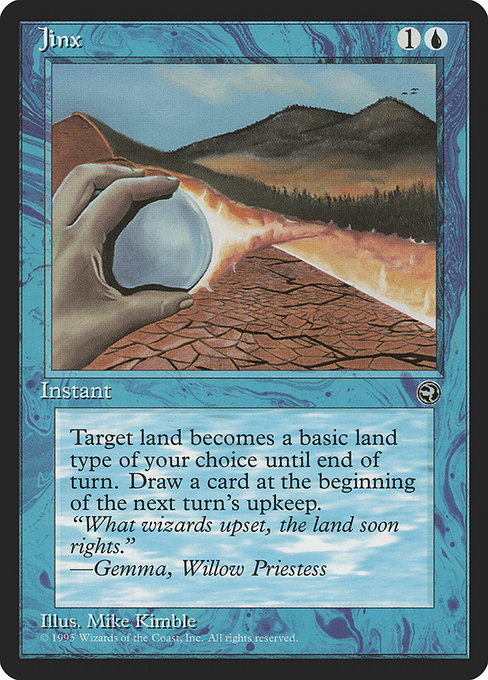
Image courtesy of Scryfall.com
Power scaling across sets: a look through Jinx’s lens
Blue mana has always carried a wheelhouse of subtle power—tempo, card advantage, and the occasional trick that tilts games in your favor by the narrow margin you can feel in your fingertips. Jinx, an Instant from the 1995 Homelands release, is a crisp snapshot of that era’s design philosophy: a modest two-mana spell that does two things at once, with repercussions that ripple through the board for the rest of the turn and into the next upkeep. It’s not the loudest shout in the room, but it’s the quiet, precise poke that reminds us why blue’s toolkit evolved the way it did. 🧙🔥💎
What Jinx actually does—and why that mattered in its day
Jinx costs {1}{U} and reads: Target land becomes the basic land type of your choice until end of turn. Draw a card at the beginning of the next turn's upkeep. That one-two punch is the heart of Jinx’s power scaling across sets. The first line can bend the battlefield in your favor in cunning ways: turning a tapped Mountain into an Island to enable specific color commitments, or flipping a land to a basic type that interacts with a deck’s galvanizing strategies—think of tribal synergies, landwalk tricks, or effects that care about being an Island, Mountain, or Plains even if you’re not technically producing that color at the moment. The second line ensures you don’t drift on the tempo wheel; you’ll rebound with a fresh card at upkeep, smoothing out the turn you invested to tilt a single land’s identity. ⚔️🎨
Flavor text:"What wizards upset, the land soon rights." —Gemma, Willow Priestess
From a design perspective, Jinx embodies the “utility spell that rewards planning” mentality. In Homelands, early cards often leaned into quirky, story-forward ideas that rewarded players for thinking about temporary physical changes on the battlefield. Jinx isn’t a raw mana engine, nor is it a guaranteed card draw engine; it’s a clever instrument for tempo and for unlocking a late-setup plan that hinges on a single land being temporarily redirected. The card’s common rarity and two-mana cost made it accessible in many Homelands decks, serving as a budget-enabling tool for players exploring color-shift and land-type interactions before the modern cantrip era fully matured. 🧙🔥💎
How power scaling reveals itself across the years
As MTG expanded, blue’s one-card-at-a-time approach evolved into a suite of cantrips and draw spells that accelerated access to information and response. Ponder, Preordain, and Opt arrived with more efficient card selection and cheaper costs, while dig-through effects and card-draw engines were reimagined to fuel grindy control shells or fast combo lines. Jinx sits at the gentler end of that spectrum—a two-mana, two-effect spell that grants a glimpse into the arc of blue’s design evolution. In newer sets, the “draw a card on upkeep” mechanic would often be pushed to a more immediate cadence or paired with additional effects to compound advantage. Yet the core idea remains familiar: tempo and card parity create footholds that scale up as the game grows more complex. 🧙🔥🎲
In Legacy and Vintage environments, where power budgets are historically leaner and longer games are common, Jinx can still find a home as a quirky tempo tool or a deliberate misdirect in a deck that wants to enforce a color-typing plan. Its ability to alter a land’s basic type—even temporarily—can interact with a surprising number of older, less-common synergies. It’s not a staple in the modern meta, but its historical significance shines through in the way it encapsulates a moment when players learned to leverage small, cross-cutting effects for future card advantage. This is the beauty of power scaling: what feels underwhelming in one era can become a surprising piece of a deck’s puzzle in another, especially when you’re chasing a specific land-type interaction or a delayed draw Revolution. 🧙🔥💎
Practical takeaways for builders and collectors
- Budget-friendly curiosity: Homelands cards like Jinx are accessible and a fun way to explore vintage-legal blue tricks without breaking the bank. Its common rarity and historical flavor make it a charming inclusion for budget blue decks in casual play and cube drafts that celebrate era-specific design. 🎲
- Deck-building considerations: If you’re drafting around land-type synergies or tribal themes, a card that temporarily redefines a land’s type can enable clever plays with other cards that care about “basic land type.” You can imagine niche combos or synergies that capitalize on such a temporary identity flip—especially in build-around ideas that hinge on color-reach or basic-land interactions. ⚔️
- Collector’s charm: The Homelands era is a talking point for many MTG historians. Jinx’s lore-friendly flavor text and classic illustrate-by-hand art give it a nostalgic glow that’s perfect for display, conversation, and a few “remember when” moments on your playtable. 🎨
From a broader lens, Jinx offers a friendly gateway into the question of how power scales across sets. When you compare its two small-but-smart effects to the sweeping multi-card draws and multi-step combos that dominate newer blue archetypes, you gain an appreciation for the design decisions that shaped MTG’s later, more explosive era. The card’s compact footprint—one instant, two hard lines of text, a memorable flavor token, and a single mana cost—remains a charming reminder that sometimes the best power grows from the simplest seeds. 💎
If you’re curating a gaming setup that nods to this journey—from the days of careful land math to today’s expansive toolbox—this product pairing might be right up your alley. A well-chosen desk accessory can be the difference between a cluttered desk and a calm play space where mind and mana flow in harmony. The product below isn’t about power alone; it’s about keeping your battlefield—and your workspace—ready for the next big draw. 🎲🧙🔥